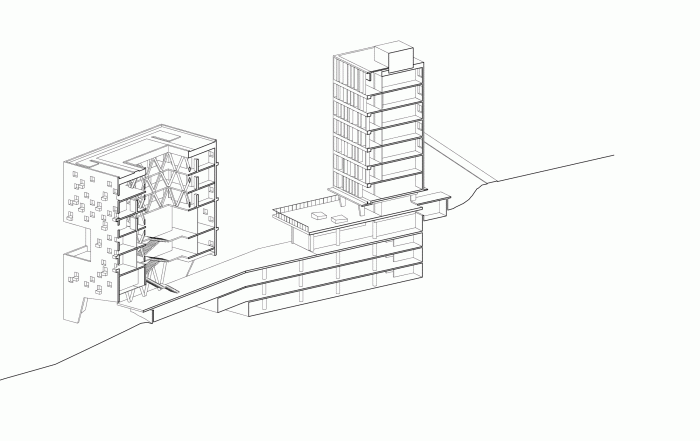该项目是对迭戈-波塔莱斯大学Huechuraba新校区总体规划进行修改的竞争结果,并确定了其第一阶段的项目,即该大学的经济和商业学院。
The project is the result of a competition for the revision of the new Diego Portales University Huechuraba Campus masterplan, and the definition of a project for its first phase, the School of Economics and Business of the University.
该地块位于圣克里斯托瓦尔山脚下,坡度较大,略高于韦丘拉巴山谷。在新校区的位置上,学校寻求在其学术发展和职业现实之间建立一个强有力的联系,因为它位于城市最重要的商业中心之一。
The site is located at the foot of San Cristobal hill, sloping and slightly raised above the Huechuraba valley. With the location of the new campus, the School seeks to build a strong link between its academic development and the professional reality, as it is at one of the most important business centers in the city.
对于建筑来说,这提出了一个挑战,即在一个规则非常不同的环境中坚持大学的身份。在那些主要用于办公室出租的建筑中,玻璃盒子缺乏明确的身份,而且设计的逻辑是短期的,我们想建立一个对比,一个有重量的结构,说的是永久性和稳定性,以伴随大学的长期承诺和超越。体积的密度,持续和老化的混凝土,显示季节变化的藤蔓覆盖的墙壁,在岁月中成熟的公园和石头广场,结合起来,随着时间的推移而巩固。
For the architecture, this presented the challenge of asserting a university identity in an environment governed by very different rules. Amid buildings that are mostly for office rental, glass boxes lacking a clear identity and designed with a short term logic, we wanted to build a contrast, a structure with weight that speaks of permanence and stability, to accompany the university in its long-range commitment and transcendence. The density of the volumes, the concrete that lasts and ages, walls to be covered with vines showing the passing of the seasons, a park that matures in years and stone squares, combine to consolidate over time.
此外,该项目寻求建立一个超越其邻居的、与地理环境的联系。它利用斜坡的优势,使庭院在领土上占主导地位,并在不同的高度建立梯田,以及一个屋顶花园,将项目的日常生活与遥远的地理环境、圣克里斯托瓦尔山和Huechuraba山谷联系起来。它们是将休闲时间与周围景观联系起来的地方。
拟议的总体规划结合了项目建设的四个元素,定义了斜坡方向的切面。学校的项目,作为第一阶段和总的一个部分,包括这四个元素,推进它们的定义。
In addition, the project seeks to build a connection beyond its neighbors, with its geographic environment. It takes advantage of the slope to render the courtyards dominant over the territory, and builds terraces at different heights, as well as a roof garden, that connects the everyday life of the project with the distant geography, San Cristobal hill, and Huechuraba valley. They are places that link leisure time with the surrounding landscape.
The proposed masterplan combines four elements for the construction of the project defining a cut in the direction of the slope. The project of the school, as a first stage and a section of the total, includes these four elements, advancing their definition:
1.一个由水平平面的线性连续构成的基地,该基地建立了密集使用的庭院,作为Huechuraba景观的阳台,容纳大学的公共项目。在第一阶段,基地被定义在三个不同层次的广场上,连接学校两个建筑的通道广场,连接未来阶段的本科生广场,以及与公园直接相关的研究生广场。在这些广场下,基地设有食堂、学校图书馆和大学的主礼堂。
1. A base from a linear succession of horizontal planes that build the courtyards with intensive use, as balconies over the Huechuraba landscape, which house the public programs of the university. In the first stage the base is defined on three squares at different levels, the access square that connects the two buildings of the school, the undergraduate square that connects to future phases, and the graduate square that is directly related to the park. Under these squares, the base houses a cafeteria, the school library and the main auditorium of the university.
2. 一个大型的8层连续酒吧,采用中性建筑风格,作为山丘的背景,容纳了需要更多模块灵活性的普通教室系统。对于经济学院来说,该建筑容纳了本科生教室,这些教室从外部走廊俯瞰项目的庭院,并与一系列高架梯田相连接,这些梯田以不止一个高度穿过建筑,在较高的楼层充当空间救济。
2. A large 8-level continuous bar, with neutral architecture, acts as a backdrop against the hill and houses the system of regular classrooms, which require more modular flexibility. For the School of Economics, this building houses undergraduate classrooms which are organized from an exterior corridor overlooking the courtyards of the project, and linked to a series of raised terraces that cross the building with more than one height, serving as spatial relief at the higher levels.
3. 3. 在基地和酒吧的前面,总体规划提出了一系列独特的建筑,与酒吧的中立性对话,建立一个风景优美的数字-地面关系。这些独特的建筑给人以某种节奏感,并从院子里框住了景观。它们也包含了每个单位最具标志性的项目,它们的多样性给校园的每个部分带来了认同感。在这个早期阶段,它容纳了研究生教室和学术办公室。该建筑的发展基于一个螺旋形的配置,它将半层的倾斜的研究生教室和其上层的办公室连接起来,这些办公室围绕着一个中央采光空隙组织其循环。它的底部被释放,留下一个大空间,连接和衔接建筑的顶部程序,硬庭院,公园和领土。
3. On the base, and in front of the bar, the masterplan proposes a series of unique buildings that dialogue with the neutrality of the bar, establishing a scenic figure-ground relationship. These unique buildings give a certain rhythm and frame the landscape from the courtyards. They also contain the most iconic programs of each unit, and their diversity gives identity to each part of the campus. At this early stage it houses graduate classrooms and academic offices. The building develops based on a spiral configuration, which links the inclined graduate rooms at half levels, and offices on its upper floors, which organize their circulation around a central light void. Its base is released, leaving a large space that connects and articulates the top program of the building, the hard courtyards, the park, and the territory.
4. 最后,一个公园被定义在场地的下部区域,与基地交织在一起。它与现有的城市区域建立了一个安全距离,并提供了一个广泛的运动项目。
4. Finally, a park is defined on the lower area of the site that is intertwined with the base. It builds a safe distance with the existing urban area, and offers an extensive sports program.
该项目是该大学建设环境可持续基础设施的强烈愿望的一部分。该项目从建筑、景观和设施方面的设计,都是为了节约能源和水,最大限度地减少对环境的影响,并为居住者提供高标准的舒适。该建筑力求减少太阳能对围护结构的影响:外墙采用高度可控的开口,以保证良好的采光和视野,中央空隙用于间接采光,并围绕其布置循环。此外,我们建议在北面和西面的外墙上建立一个种植园系统,种植落叶藤蔓,在炎热的月份提供阴凉和湿度,并建立一个屋顶花园,作为隔热的缓冲区。在本科生建筑中,东面的外墙是由装饰玻璃包覆的混凝土墙构成,反射着山体,并通过受控的开口将光线过滤到教室中。在西面,我们设计了一个大型的垂直混凝土格子,上面有多年生植物的花盆,为走廊和教室遮阳。最后,我们力图在炎热的月份利用来自西方的微风,在教室建筑中产生交叉通风,在研究生楼的中央空隙中产生向上的空气流动。
The project is part of a strong desire of the university to build environmentally sustainable infrastructure. The project is designed, from the architecture , landscape, and facilities, in terms of savings in energy and water, minimizing its impact on the environment, and high standards of comfort for its occupants. The building seeks to reduce solar impact on the envelope: the exterior graduate walls are constructed with highly controlled openings, just enough for good lighting and views, and a central void for indirect light, around which the circulation is laid out. Furthermore, we propose a system of planters on the the north and west facades, to grow deciduous vines that provide shade and humidity during the hot months, and a roof garden that acts as a buffer for thermal insulation. In the undergraduate building, the east facade is constructed from a concrete wall clad in decorated glass reflecting the hill and filtering light into the classrooms through controlled openings. To the west we design a large vertical concrete lattice, with perennial vegetation planters, shading the corridor and classrooms. Finally, we seek to exploit the breeze from the west in the hot months, to generate cross ventilation in the classroom building and upward movement of air in the central void of the graduate building.
Architects: Duque Motta & AA, Gabriela Manzi, Rafael Hevia
Year: 2013
Photographs:Fernando Guerra | FG+SG
Manufacturers: Arauco, Cbb ReadyMix, Cintac®, MK, Tupemesa
Project Management:Unidad Servicios Externos UDP
Structures:Luis Soler P. & Asociados
Landscape:Francisca Saelzer
Sustainability Consultant:Edificioverde S.A.
Lighting:Mónica Pérez & Asociados
Construction:Bravo e Izquierdo
Technical Inspection:Inspecta S.A.
Collaborator:Catalina Ventura
External Collaborator:Martin Holmes
City:Santiago
Country:Chile
























































